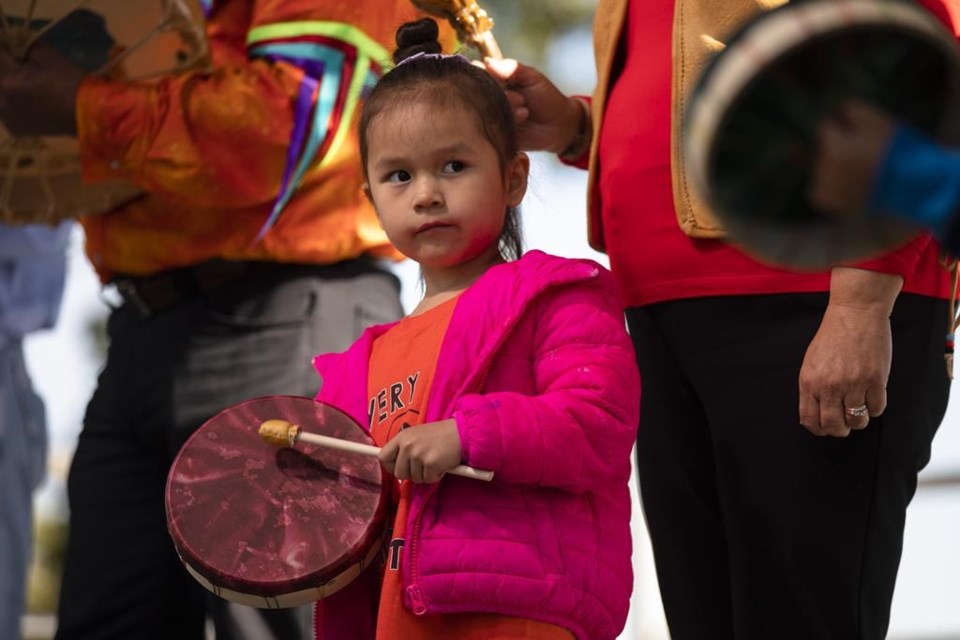With sunrise ceremonies, Indigenous songs and moments of reflection, communities across Ontario marked the National Day of Truth and Reconciliation on Friday.
The federal statutory holiday, also known as Orange Shirt Day, was established last year to remember children who died while being forced to attend residential schools, those who survived, and the Indigenous communities affected by lasting trauma.
In downtown Toronto, a gathering at the city's Nathan Phillips Square began with a sunrise ceremony followed by Indigenous musical performances and speakers who addressed the crowd.
Jessica Keeshig-Martin, an Indigenous woman who came to the square, said her grandmothers attended residential schools, and she was there to pray for her community.
"It is important for me to be here for my own healing and to pray for the healing of our communities, and for those young souls who were lost and who are within those unmarked graves that have been found," she said.
Keeshig-Martin urged others to learn more about what happened to Indigenous people as a result of the residential school system.
"It is really important to learn the truth about what happened so we can start talking about how to move forward in the future in a good way," she said.
Nancy Logan, a Calgary resident who was in Toronto on vacation, said she came to the downtown event to learn more about Indigenous communities.
"We need to grow together, there is no one (person) who can change it, we all need to come together and learn, and grow together to help each other," she said.
Growing up, Logan said she knew very little about the horrors of the residential school system and was glad to see more people were now aware of the "absolute tragedy."
"It is absolutely heartbreaking," she said. "Today is great to have but you have to think about all year."
Outside Ontario's legislature on Friday, Indigenous leaders and politicians gathered to unveil a new garden and plaque that commemorates the continuing treaty relationship between the Crown and Indigenous Peoples.
Elder Carolyn King, the former chief of the Mississaugas of the Credit First Nation, helped create the garden.
"The first step is to recognize that we were there and we're still here, and then the relationship building starts and what that might be is wonderful permanent things like this, a garden here that recognizes that relationship that maybe should have been there for a much longer time," she said.
Chief Stacey LaForme of the Mississaugas of the Credit First Nation said he spent Thursday with thousands of students who wanted to learn about reconciliation and the meaning of Orange Shirt Day.
"I have never seen this many people want to do this before, so I'm pleased by that," he said.
"It's very fitting that we're unveiling the treaty plaque today because treaties are definitely a part of reconciliation and so we still have a lot of work ahead of us, but maybe for the first time I think we're up to it."
Premier Doug Ford said the day was a time for Ontarians to reflect on the dark legacy of residential schools while also honouring survivors of the system and those who did not make it home.
"I encourage everyone to learn about and reflect on the history of residential schools, the harmful impact they've had on Indigenous families and entire communities and to commemorate all those who've been affected," he said. "It’s a long road ahead but we will walk together in the spirit of truth and reconciliation."
In Niagara Falls, Ont., a sunrise ceremony was followed by an event to mark the day.
Esk'etemc Chief Fred Robbins spoke to a crowd about his time at a residential school and the effect it had on his life even after he left.
"When I first left the residential school at the age of 11 or 12, they dropped me off at Alkali Lake in front of the church," he said.
"And before they dropped me off, they dressed me up in brand new clothes ... I stuck out like a sore thumb in my community, because almost every other child in my community was wearing hand-me-downs."
Robbins said he felt like an outsider.
"Talk about displacement. I had no clue where I was, not a clue," he said. "I never grew up on a reservation, I grew up in a residential school."
Robbins said he left his parents' house two years later because he didn't feel like he knew them.
Reconciliation is possible, Robbins said, but it will take time.
"As (former Canadian senator) Murray Sinclair said, it took them 150 years to tear us down as First Nations people, it may take us another 150 years to build us back up," said Robbins. "And that has to start today."
Prime Minister Justin Trudeau also spoke at the event after meeting with residential school survivors earlier in the day.
"Reconciliation is the responsibility of every single Canadian. And we know it will take time," Trudeau told the crowd.
"It’s important to listen, to learn and to move forward, to not repeat the mistakes of the past. Scars don’t heal overnight and trust can take a long time to rebuild but we will be there together, every step of the way."
- with files from Liam Casey.
This report by The Canadian Press was first published Sept. 30, 2022.
Sharif Hassan and Jessica Smith, The Canadian Press



